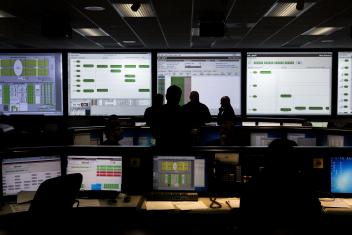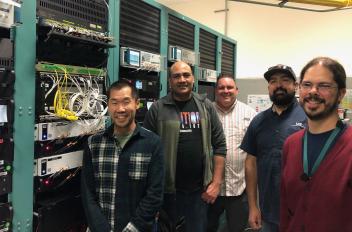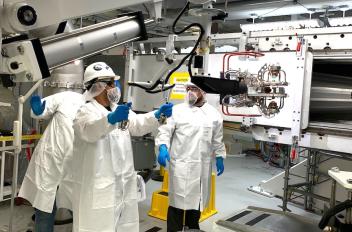Disclaimer: This article is more than two years old. Developments in science and computing happen quickly, and more up-to-date resources on this topic may be available.
To achieve its historic fusion ignition shot—and the subsequent reproduction—the National Ignition Facility (NIF) needed a lot of things to go just right. Each of the 192 laser beams must deliver just the right amount of energy to just the right spot at just the right time, within a few billionths of a second and a few square millimeters.
Making sure all these parameters work just so is the role of the NIF Computing (NIFC) control systems. “We’re responsible for the precise control that achieves all these characteristics,” says Mikhail Fedorov, team lead for the Integrated Computer Control System (ICCS).
When and Why to Update ICCS
NIFC aims to make three major software releases each year to enable new capabilities, for reactive maintenance when something can be improved, and for preventative maintenance to support things like new hardware. These updates also improve reproducibility, allowing NIF to continue achieving ignition more frequently.
One important recent step toward more precise and accurate NIF pulse shape delivery is the deployment of a new High-Fidelity Pulse Shaping (HiFiPS) capability. This new system enhances the accuracy of a NIF laser pulse’s shape, reducing shaping errors to less than 1% and increasing the shot-to-shot stability of some of the features in the pulse shapes by a factor of up to three. This is one of the contributing factors to ignition. “The laser pulse has a certain shape, and that’s one of the controls that experimentalists need to achieve ignition or conduct any other experiment. HiFiPS is moving us toward more reproducible shots,” explains Fedorov.
But with high yield comes new challenges, and the need for more automation. The Target Alignment System (TAS), which uses video cameras and other electronics to align the cryogenic target to within tens of microns, is especially sensitive to radiation damage, and should be removed before a shot to maximize its lifespan—especially as NIF anticipates producing more and more high-yield shots. Replacing the system between shots requires precise calibration, which takes more than three days to complete manually. Fedorov’s ICCS team recently automated this operation, shrinking the time recalibration takes down to 10 to 13 hours.
Avoiding Surprises Through Testing
Before deploying any software updates to NIF, the ICCS quality assurance team, led by Michael Flegel, confirms everything works as needed. They start in the Continuous Integration environment, where the automated build and test systems assure the newly developed code works well with the existing software. The software is then delivered to the offline testing environment and, finally, deployed to production in the NIF controls system. This allows the ICCS team to find and fix any issues early on, and they’ve “never experienced a showstopper,” Flegel comments.
Fully qualifying the control system software—which last occurred on August 2—requires about 18,000 tests, taking anywhere from a few hours to over a day. After deploying in the morning, the team exercises NIF through a shot to check that the system is still working properly.
“The facility doesn’t like perturbation. The team wants steady, predictable behavior with exceptionally high quality,” notes Allan Casey, NIFC division leader. “If we have a bug, it can be an operational impediment, a quality of shot impediment, or any number of problems, and we really don’t want that to happen.”
Ultimately, through extensive design and coding reviews, validation, and verification, the primary goal is to guarantee everything continues to run smoothly. And if something does go wrong, the team’s combined knowledge, round-the-clock representatives, and automated analytical tools ensure any issues are resolved before the next morning.
“We don’t want surprises, and we try really hard through our processes to avoid it. However, if an issue does affect the facility, we have processes and procedures to help guide issues. It’s never like the sky is falling,” states Casey.
Past Decisions Carry NIFC Into the Future
Many of these updates would not be possible without the flexibility that was proactively built into the system during NIF’s development. ICCS is intentionally highly object-oriented and scalable, so the software can be tested on multiple levels—from unit testing, to integrated component tests and, finally, end-to-end testing that simulates the execution of NIF laser shots. Each shot requires 2 million device moves and 66,000 control points, so this foresight saves a lot of time. With the help of the ICCS team’s continued maintenance and refurbishment—and with close collaboration with scientists and engineers to validate and verify the changes—Casey is optimistic that the system still has another 20 years of life left.
“The control team was excited to play a part in achieving ignition. To have worked on the control system for two decades and finally achieve what was always promised to be possible was tremendously rewarding, and justified all the design decisions and effort put in,” Casey says.
“We’re part of the bigger NIF team, and everything we do is a multidisciplinary effort,” adds Fedorov.
—Anashe Bandari




